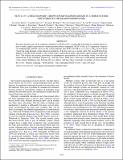| dc.contributor.author | Irwin, Jonathan | |
| dc.contributor.author | Buchhave, Lars | |
| dc.contributor.author | Berta, Zachory K. | |
| dc.contributor.author | Charbonneau, David | |
| dc.contributor.author | Latham, David W. | |
| dc.contributor.author | Burke, Christopher J. | |
| dc.contributor.author | Esquerdo, Gilbert A. | |
| dc.contributor.author | Everett, Mark E. | |
| dc.contributor.author | Holman, Matthew J. | |
| dc.contributor.author | Nutzman, Philip | |
| dc.contributor.author | Berlind, Perry | |
| dc.contributor.author | Calkins, Michael L. | |
| dc.contributor.author | Falco, Emilio E. | |
| dc.contributor.author | Johnson, John A. | |
| dc.contributor.author | Gazak, J. Zachary | |
| dc.contributor.author | Winn, Joshua Nathan | |
| dc.date.accessioned | 2018-06-21T13:34:25Z | |
| dc.date.available | 2018-06-21T13:34:25Z | |
| dc.date.issued | 2010-07 | |
| dc.date.submitted | 2010-02 | |
| dc.identifier.issn | 0004-637X | |
| dc.identifier.issn | 1538-4357 | |
| dc.identifier.uri | http://hdl.handle.net/1721.1/116459 | |
| dc.description.abstract | We report the discovery of an eclipsing companion to NLTT 41135, a nearby M5 dwarf that was already known to have a wider, slightly more massive common proper motion companion, NLTT 41136, at 2″.4 separation. Analysis of combined-light and RV curves of the system indicates that NLTT 41135B is a (31-34) ± 3M Jup brown dwarf (where the range depends on the unknown metallicity of the host star) on a circular orbit. The visual M dwarf pair appears to be physically bound, so the system forms a hierarchical triple, with masses approximately in the ratio 8:6:1. The eclipses are grazing, preventing an unambiguous measurement of the secondary radius, but follow-up observations of the secondary eclipse (e.g., with the James Webb Space Telescope) could permit measurements of the surface brightness ratio between the two objects, and thus place constraints on models of brown dwarfs. | en_US |
| dc.publisher | American Astronomical Society/IOP Publishing | en_US |
| dc.relation.isversionof | http://dx.doi.org/10.1088/0004-637X/718/2/1353 | en_US |
| dc.rights | Article is made available in accordance with the publisher's policy and may be subject to US copyright law. Please refer to the publisher's site for terms of use. | en_US |
| dc.source | Astrophysical Journal | en_US |
| dc.title | NLTT 41135: A FIELD M DWARF + BROWN DWARF ECLIPSING BINARY IN A TRIPLE SYSTEM, DISCOVERED BY THE MEARTH OBSERVATORY | en_US |
| dc.type | Article | en_US |
| dc.identifier.citation | Irwin, Jonathan et al. “NLTT 41135: A FIELD M DWARF + BROWN DWARF ECLIPSING BINARY IN A TRIPLE SYSTEM, DISCOVERED BY THE MEARTH OBSERVATORY.” The Astrophysical Journal 718, 2 (July 2010): 1353–1366 © 2010 The American Astronomical Society | en_US |
| dc.contributor.department | Massachusetts Institute of Technology. Department of Physics | en_US |
| dc.contributor.department | MIT Kavli Institute for Astrophysics and Space Research | en_US |
| dc.contributor.mitauthor | Winn, Joshua N. | |
| dc.relation.journal | Astrophysical Journal | en_US |
| dc.eprint.version | Final published version | en_US |
| dc.type.uri | http://purl.org/eprint/type/JournalArticle | en_US |
| eprint.status | http://purl.org/eprint/status/PeerReviewed | en_US |
| dc.date.updated | 2018-06-15T13:23:22Z | |
| dspace.orderedauthors | Irwin, Jonathan; Buchhave, Lars; Berta, Zachory K.; Charbonneau, David; Latham, David W.; Burke, Christopher J.; Esquerdo, Gilbert A.; Everett, Mark E.; Holman, Matthew J.; Nutzman, Philip; Berlind, Perry; Calkins, Michael L.; Falco, Emilio E.; Winn, Joshua N.; Johnson, John A.; Gazak, J. Zachary | en_US |
| dspace.embargo.terms | N | en_US |
| dc.identifier.orcid | https://orcid.org/0000-0002-4265-047X | |
| mit.license | PUBLISHER_POLICY | en_US |
